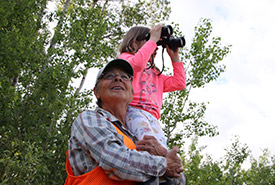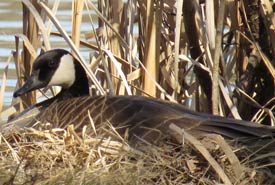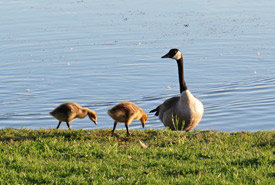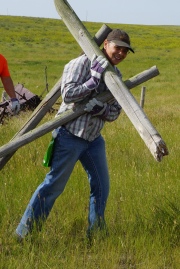The magic of nature

Denise Harris with her granddaughter (Photo by NCC)
When I first started going to my neighbourhood park, I often saw disturbing human behaviour; some from children as young as three. In the "School of Life," where my field-testing on educating others about our waterfowl neighbours initially failed, I am now finding much more success with it.
One life lesson arrived mid-morning one day when five preschoolers decided to chase and throw gravel and sticks at some geese at my neighbourhood park. The healthy geese ran away, but one happened to get injured by the kids while protecting other geese in its territory. As I approached the children, I squatted down to their eye level. Not only did the five kids tune in, but their mothers came running. I pointed out the injured goose and explained that “father goose” was trying to protect his mate and unhatched baby goslings. “Oh!” the kids responded. They didn’t know.
Related blog posts

Canada goose (Photo by Denise Harris)
Meeting the mothers at their eye level, I repeated the same message. I then leaned down to the children and asked, “What would your parents do if a porcupine came wandering into your backyard while you were busy playing?” The kids looked at their moms while I answered, “They would do whatever it takes to protect you.” All the mothers agreed.
I led the group onto the peninsula, pointing out the three geese pairs’ territories. Then, I explained, incorporating body gestures for emphasis, how the territorial geese pairs had worked together to keep five juvenile geese pairs out of their collective territory. The mothers were surprised; they had no idea what the geese were up to or that they could do what they did. I successfully got my message across without conflict. Intriguingly, the mothers initially saw me, a granny, as a bigger threat than the territorial goose.

Canada geese (Photo by Denise Harris)
The year prior, when I tried to stop children from capturing goslings, I told the kids to stop what they were doing. The School of Hard Knocks quickly taught me that this puts you in a position of defense rather than offence — a far weaker position as you try to dig yourself out of the hole you put yourself in.
When you see school-aged children disrespecting wildlife, ask them why. Most times, if they are honest, they’ll say it’s because they are afraid. What’s important is to tailor your message to your audience. With parents, I most often share a story of a goose transitioning into a fledgling.
When people ask you a question that you don’t have the answer to, “Don’t fake it — relate it.”
Perhaps the most important message of all is to share your own personal awe and joy as non-judgmental. Besides, no matter how old we are, “a spoonful of sugar makes the medicine go down.”


